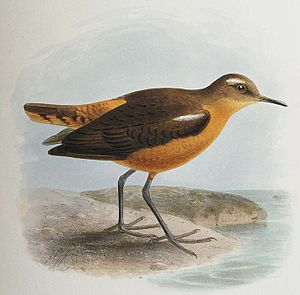Social runner
| Social runner | ||||||||
|---|---|---|---|---|---|---|---|---|

Common runner ( Prosobonia leucoptera ) |
||||||||
| Systematics | ||||||||
|
||||||||
| Scientific name | ||||||||
| Prosobonia leucoptera | ||||||||
| ( Gmelin , 1789) |
The Tahiti Sandpiper ( Prosobonia leucoptera ), also called Tahiti beach runner or in the Tahitian language as toromē called, is an extinct species of bird in the family Scolopacidae . It was endemic to Tahiti .
discovery
The social runner was discovered in 1773 on Captain James Cook's second voyage to the South Seas. It appears that only one specimen was collected, which is now in the Museum Naturalis in Leiden , the Netherlands .
Two (possible) specimens, which were collected by William Anderson between September 30 and October 11, 1777 on Moorea , formed the basis for the description of the white-winged common sandpiper ( Prosobonia ellisi ). The three specimens mentioned by John Latham in 1787 are all different. However, the remaining specimen (Naturalis-RMNH 87556) cannot be clearly identified, nor can it be traced with complete certainty how it came into the possession of the museum. It may have been acquired in 1819 together with other Forster specimens (Stresemann, 1950). There is also a drawing by Georg Forster and a lithographic reconstruction by John Gerrard Keulemans .
description
The social runner reached a size of 17.5 centimeters. The wing length was 11.3 centimeters, the tail length 5.4 centimeters and the barrel was 3.4 centimeters long.
The parting was blackish brown. The color of the neck and the sides of the head was dark brown. The reins and ear covers were reddish with a white stain behind the eye. The cheeks were rusty red and the throat brownish white. The back and wings were blackish brown. It was characterized by a small crescent-shaped white spot on the wing bend, which was formed by some of the small wing covers. The two central tail feathers were blackish brown, the rest were reddish brown with black banding. The underside was rust-red and unbanded. The iris and beak were black. The legs and feet were greenish in color.
Way of life
The social runner was a ground breeder and preferred to be near small rivers.
die out
In 1777 it was described as frequent by William Anderson, the ship's doctor on Cook's third voyage to the South Seas. Since Cook's ships were plagued by rats and cockroaches on this voyage, James Cook had ropes stretched from the ships to the Tahitian shore to get rid of the vermin. As a ground breeder, the social runner was easy prey for the rats. A few years after 1777 it was extinct.
literature
- James Cowan Greenway : Extinct and Vanishing Birds of the World . Dover Publications Inc., New York 1967, ISBN 0-486-21869-4 .
- Errol Fuller: Extinct Birds . 2000, ISBN 0-8160-1833-2 .
- David Day: The Doomsday Book of Animals . Ebury Press, London 1981, ISBN 0-670-27987-0 .
- Dieter Luther: The extinct birds of the world . Westarp Sciences, 1986, ISBN 3-89432-213-6 .
- Walton Beacham: World Wildlife Fund Guide to Extinct Species of Modern Times . 1997, ISBN 0-933833-40-7 .
swell
- Gmelin , Johann Friedrich (1789): [Description of Prosobonia leucoptera ]. In: Systema Naturae per regna tria naturae secundum classes, ordines, genera, species, cum characteribus, differentiis, synonymis, locis (13th ed.) 1 , part II: 678. Georg Emanuel Beer, Lipsiae Leipzig .
- Greenway , James C. (1967): Tahitian Sandpiper. In: Extinct and Vanishing Birds of the World (2nd ed.) : 263-264. Dover Publications, New York.
- Hayman , Peter; Marchant, John & Prater, Tony (1986): Shorebirds: an identification guide to the waders of the world . Houghton Mifflin, Boston. ISBN 0-395-60237-8
- Latham , John (1785): [White-winged Sandpiper]: In: A general synopsis of birds 3 : 172, plate 82. London.
- Latham , John (1824): [White-winged Sandpiper]: In: A general history of birds 9 : 296.
- Stresemann , Erwin (1950). Birds collected during Capt. James Cook's last expedition (1776-1780). Auk 67 (1): 66-88. PDF full text
- Zusi Richard L. & Jehl , Robert R. Jr. (1970): The systematic relationships of Aechmorhynchus , Prosobonia and Phegornis (Charadriiformes; Charadrii). Auk 87 : 760-780. PDF full text
Web links
- Prosobonia leucoptera in the endangered Red List species the IUCN 2008. Posted by: BirdLife International , 2008. Accessed on January 1 of 2009.
- 3D view of the RMNH 87556 in the Museum Naturalis, Leiden (requires QuickTime ).
- BirdLife Species Factsheet .
- Natural History Museum : Original drawing of the walker by Georg Forster from 1774.